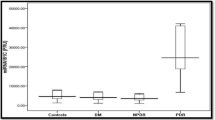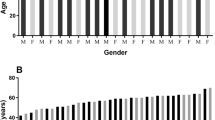Summary.
Objective: The deposition of advanced glycation end products is enhanced in Diabetes mellitus (DM) and has been linked to diabetic complications such as a microvascular disease. Glycated proteins have receptors on mononuclear blood cells (MBCs) and have been shown to generate reactive oxygen species altering gene expression and modifying cellular targets, such as endothelial cells. Retinal angiopathy is a frequently observed microvascular complication in DM-patients. Because of the central role of activated MBCs, we hypothesised a functional link between specific alterations in gene expression of MBCs, an increased activity of matrix proteases in serum, and the extent of retinal angiopathy in DM.
Material and methods: An appearance and proliferation index of diabetic retinopathy was evaluated in 38 DM-patients using fluorescein angiography. Alterations of gene transcription levels in MBCs were investigated using hybridisation of individual mRNA-pools to Atlas Array with a concomitant quantification of specific cDNAs by “Real-Time”-PCR. The activity of matrix metalloproteinases MMP-2 and MMP-9 in individual serum samples was measured by zymography combined with densitometric imaging system.
Results and conclusions: Hybridisation to Atlas Array of mRNA-pools isolated from MBCs revealed an enhanced expression of recoverin in DM-patients compared to the control group. “Real-Time”-PCR showed the highest recoverin levels in the DM-subgroup with a high proliferation index. MMP-2 activity was highly increased in 36% of all patients, and in 44, 44, and 19% of patients with proliferative retinopathy, advanced proliferative retinopathy, and no detectable proliferation respectively. In those 3 groups MMP-9 activity was highly increased in 56, 67, and 31% of patients respectively, and in 44% of all DM-patients. In contrast to patients with active proliferation, the simultaneous high activation of all three genes was not observed in patients without active proliferation. The ex vivo molecular imaging system developed in this work may be helpful for the prediction of active proliferative retinopathy in DM.
Similar content being viewed by others
Author information
Authors and Affiliations
Rights and permissions
About this article
Cite this article
Golubnitschaja, O., Jaksche, A., Moenkemann, H. et al. Molecular imaging system for possible prediction of active retinopathy in patients with Diabetes mellitus. Amino Acids 28, 229–237 (2005). https://doi.org/10.1007/s00726-005-0173-1
Received:
Accepted:
Published:
Issue Date:
DOI: https://doi.org/10.1007/s00726-005-0173-1




